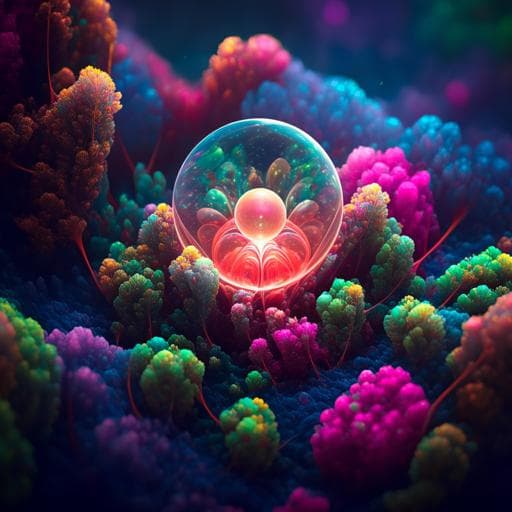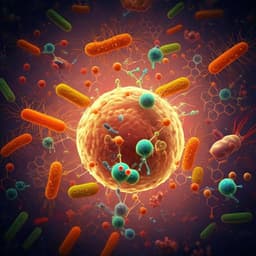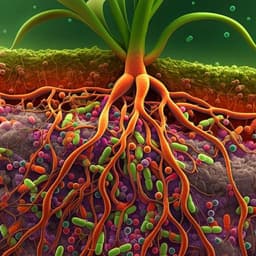
Medicine and Health
Insights into the assembly of the neovaginal microbiota in Mayer-Rokitansky-Küster-Hauser (MRKH) syndrome patients
N. Chen, L. Hao, et al.
This longitudinal study reveals intriguing insights into the neovaginal microbiota assembly in MRKH syndrome patients post-laparoscopic peritoneal vaginoplasty. Early microbiota displayed stochastic characteristics, with *Enterococcus faecalis* and Mycoplasmas flourishing. Remarkably, the neovagina evolved to mimic a normal vagina over time, hinting at ways to enhance neovaginal health. This groundbreaking research was conducted by the authors listed below.
~3 min • Beginner • English
Introduction
Neovaginas are surgically created to treat uterovaginal agenesis in women with MRKH syndrome or as part of gender-affirming surgery. Prior work has largely focused on transgender neovaginas and indicated polymicrobial ecosystems distinct from normal vaginas. MRKH patients have hypoplasia of the uterus, cervix, and upper vagina but normal female karyotype and steroid hormone production. The host vaginal epithelium, a stratified squamous epithelium rich in glycogen during reproductive age, supports Lactobacillus dominance; reduced glycogen in menopause is associated with decreased Lactobacillus and increases in BV-associated anaerobes. Limited studies suggest that neovaginas created with peritoneum or other tissues undergo metaplasia to a glycogen-containing stratified squamous epithelium over time, but a comprehensive spatiotemporal characterization of how the neovaginal microbiota establishes and evolves has been lacking. The research question was to determine how the neovaginal microbiota assembles over time after laparoscopic peritoneal vaginoplasty in MRKH patients, what sources seed this microbiota, and which host and ecological factors shape its development toward a stable community structure.
Literature Review
Previous studies of neovaginal microbiota have been primarily cross-sectional, using cultivation and microscopy, often in transgender women with penile skin-lined neovaginas, generally reporting polymicrobial communities distinct from cisgender female vaginal microbiota. A metaproteomic study found penile skin-lined neovaginas harbor communities similar to those of an uncircumcised penis rather than a vagina. In MRKH women, a prior study reported dysbiotic neovaginal microbiota years after surgery with an increase in Lactobacillus following squamous epithelialization. Foundational literature demonstrates that vaginal epithelium glycogen supports Lactobacillus dominance in reproductive-age women, while menopausal atrophy and reduced glycogen favor BV-associated anaerobes. Studies of different neovaginal construction techniques (amniotic membrane, peritoneum, tissue-engineered biomaterials) suggest eventual metaplasia to glycogen-containing stratified squamous epithelium. While infant gut microbiota assembly is well studied, establishment of the vaginal microbiota remains less understood; the MRKH neovagina offers a unique model to longitudinally observe assembly dynamics and ecological drivers.
Methodology
Study population and design: 39 Chinese women with MRKH syndrome (age at surgery 17–35 years; mean 24.85 ± 4.06) underwent laparoscopic peritoneal vaginoplasty and were followed longitudinally. Sampling timepoints were: PRE (0–2 days pre-surgery), P14D (14.11 ± 2.04 days), P90D (91.56 ± 7.76 days), P6/12M (8.79 ± 2.50 months), and P2/4Y (42.81 ± 8.18 months). Perioperative management included oral laxatives for bowel preparation, prophylactic antibiotics (cefoxitin sodium plus metronidazole for 3–7 days; one patient received clindamycin), and paraffin oil applied to dilators.
Sampling: A total of 456 samples were collected: vaginal (pre-surgery dimple and post-surgery neovagina, n=142), peritoneal fluid (n=31), fecal (n=111), tongue coating (n=108), abdominal skin (n=33), and control saline (n=31). Vaginal samples were clinician-collected at PRE and P90D, and self-collected at P6/12M and P2/4Y. Stool and tongue samples were self-collected. Peritoneal fluid, abdominal skin, and saline were collected during surgery. Samples were preserved at room temperature with stabilizing reagent and stored at −80 °C. Metadata included clinical exams, questionnaires (neovaginal management, function, health), pH measurements, and morphological assessments (colposcopy, iodine staining). Biopsies from three MRKH patients (dimple, neovagina at P90D, P6/12M, P2/4Y) and three healthy controls (upper third vagina) were processed (formalin fixation, paraffin embedding, ~3 µm sections) and stained with HE and PAS to assess epithelial development and glycogen.
Reference cohort: Vaginal metagenomes from 472 healthy adult Chinese women were included as references, excluding ages 45–55 to avoid perimenopausal fluctuations: premenopausal (H_R, n=237, age 39.99 ± 2.54) and postmenopausal (H_M, n=235, age 58.09 ± 3.86).
Sequencing and preprocessing: DNA extraction followed standardized protocols with bead beating and phenol-chloroform purification. Libraries were sequenced on BGI-DIPSEQ (100/150 bp paired-end). Quality filtering used fastp (Phred ≥20, length ≥30). Human reads were removed by Bowtie2 (GRCh38, very-sensitive). Post-QC yields: MRKH cohort 25,073,576,842 metagenomic reads; healthy cohort 1,738,415,044 reads.
Taxonomic profiling and diversity: MetaPhlAn3 (db v30, read_min_len 70) profiled taxa; rare species in fewer than three samples were discarded; bacterial profiles were renormalized. Alpha diversity (Shannon index, observed species) and beta diversity (Bray-Curtis) were computed using vegan. PERMANOVA tested associations between microbial community structure and metadata at P2/4Y.
Community typing and networks: Vagitype was assigned by dominant species (>30% relative abundance; otherwise "Diverse"). Dirichlet Multinomial Mixtures (DMM) clustered MRKH vaginal communities (PRE, P14D, P90D, P2/4Y). Co-occurrence networks per timepoint were inferred with SparCC (1000 bootstraps), edges retained at prevalence >10% and FDR < 0.05, visualized with igraph.
Source tracking and strain analysis: FEAST estimated contributions from potential sources (pre-surgery dimple, peritoneal fluid, stool, tongue, skin, saline). Species present in ≥10% of each source (5% for peritoneal fluid) were included; samples with 500–500,000,000 reads were retained. Strain-level analysis used StrainPhlAn, selecting species with adequate marker coverage; multiple sequence alignments and phylogenetic trees were built; normalized pairwise phylogenetic distance <0.1 defined identical strains. Strain sharing between neovagina and pre-surgery sources (dimple, stool, tongue, skin) was enumerated and rates computed.
Statistical analyses: Group comparisons used Kruskal-Wallis with FDR correction (significance at adjusted P < 0.1) and Wilcoxon rank-sum for two-group tests (FDR-adjusted). Generalized estimating equations (geepack geeglm) assessed the effect of pre-surgery dimple presence/abundance and stool abundance on post-surgery neovaginal species abundance across timepoints (log10-transformed, scaled), with FDR-adjusted significance at P < 0.1. Random forest models with 10-fold cross-validation predicted species abundance changes between timepoints from the previous timepoint composition (species prevalence >10%, mean abundance ≥0.1%, at least 3 samples with >0.1%).
Morphological assessment: Colposcopy and iodine staining documented epithelialization; HE and PAS stains confirmed a fibrous stroma lined with stratified squamous epithelium and glycogen accumulation at all assessed stages. Neovagina length was ~9 cm initially and 9.4 ± 1.11 cm at P2/4Y.
Key Findings
- Early assembly and antibiotic effects: At 14 days post-surgery (P14D), species richness dropped significantly (Wilcoxon P < 0.0001) and relative abundances of Lactobacillus iners, Prevotella timonensis, and Atopobium vaginae declined (FDR-adjusted P < 0.1). Species intrinsically insensitive/resistant to cephalosporins, including Enterococcus faecalis, Ureaplasma parvum, Ureaplasma urealyticum, and Mycoplasma hominis, bloomed in some patients. Despite perturbation, intra-individual dissimilarities between adjacent timepoints remained lower than inter-individual dissimilarities (Wilcoxon P < 0.05), indicating continuity.
- Intermediate BV-like state: By P90D, after squamous epithelium reached the apex, the community became polymicrobial with BV-associated anaerobes abundant. Prevotella (mainly P. timonensis and P. bivia) significantly increased to ~29% mean relative abundance at P90D (FDR-adjusted P < 0.1). Gardnerella vaginalis and A. vaginae increased; in 11 patients at P6/12M, G. vaginalis was often most abundant. Lactobacillus spp. remained low on average (<16% at P90D and P6/12M); few patients were Lactobacillus-dominated (P90D 3/27; P6/12M 0/11).
- Long-term convergence to pre-surgery state: At 2–4 years (P2/4Y), the neovaginal microbiota closely resembled the pre-surgery dimple; among the top 20 species, only Prevotella buccalis differed significantly (FDR-adjusted P < 0.1). L. iners colonized all recalled patients; L. iners, L. crispatus, and total Lactobacillus significantly increased relative to earlier stages (FDR-adjusted P < 0.1). Lactobacillus levels: PRE 40.8%, P2/4Y 38.3%, versus H_R 75.6% and H_M 17.1%. More patients at P2/4Y were dominated by L. crispatus or L. gasseri compared to PRE. Vaginal pH showed acidification over time: pH <5 in 1/36 (P14D), 10/26 (P90D), and 15/20 (P2/4Y).
- Community typing and networks: DMM revealed three clusters; cluster 1 (L. iners, U. parvum, P. bivia contributors) dominated from PRE to P90D; by P2/4Y, 19/27 (70.4%) transitioned to cluster 2 (contributors P. timonensis, Finegoldia magna, Peptoniphilus harei). Patients in cluster 2 at PRE deviated least by P2/4Y. Co-occurrence networks evolved from sparse (P14D) to dense (P2/4Y), recapitulating many PRE interactions; a P. timonensis-centered network was nascent at P90D and prominent by P2/4Y.
- Source tracking: FEAST attributed the largest share of the neovaginal microbiota to the pre-surgery dimple, increasing from 40.76% (P14D) to 79.30% (P2/4Y). Stool contributed on average 22.09%. Peritoneal fluid peaked at 2.17% at P90D then waned; minor contributions from tongue and skin were detected, with skin/environment more noticeable at P2/4Y.
- Strain origin and persistence: Strain-level analyses showed lower phylogenetic distances within individuals across body sites, especially dimple–neovagina and stool–neovagina. Species classified into: (1) only intravaginal sharing (4/75; e.g., L. crispatus), indicating primary origin from the dimple; (2) both intravaginal and extravaginal sharing (21/75), with high sharing for L. iners, U. parvum, P. bivia, Streptococcus anginosus group, P. disiens; (3) only extravaginal sharing (35/75), predominantly stool; (4) no detected sharing (15/75). At P14D, sharing occurred more often with the dimple and exclusively so for L. iners, U. parvum, G. vaginalis, Sneathia amnii, and P. amnii. Long-term maintenance of strains was observed; L. crispatus strains in two of four patients persisted to P2/4Y.
- Factors shaping assembly: MRKH type correlated with the relative abundance of specific species (e.g., Atopobium minutum, Bifidobacterium dentium, P. timonensis, Streptococcus agalactiae; FDR-adjusted P < 0.05). GEE showed positive associations between pre-surgery status and post-surgery neovaginal abundance for many species, primarily driven by the dimple. L. crispatus acquisition and abundance were strongly associated with prior presence and abundance in the dimple. Some species with stool-only strain sharing (e.g., Faecalibacterium prausnitzii) still showed associations with dimple status. Random forest identified P. timonensis, F. magna, P. harei, and L. iners among the most predictable species driving temporal changes, consistent with DMM results.
- Morphology: Colposcopy and histology confirmed progressive squamous epithelialization from the opening upward, visible by P14D and reaching the apex by P90D, with further maturation by P2/4Y. All biopsies showed stratified squamous epithelium with glycogen (PAS-positive). Neovaginas lacked cervical connection and mucus, and lacked rugae typical of normal vaginas.
Discussion
The study demonstrates that neovaginal microbiota assembly in MRKH patients is governed by the initial species pools (primarily the pre-surgery dimple and secondarily the gut) and by progressive selective forces from the evolving neovaginal environment, notably development of a glycogen-rich squamous epithelium. Early post-surgery conditions and antibiotic exposure produced stochastic community structures with blooms of antibiotic-insensitive taxa such as Enterococcus faecalis, potentially from hospital sources. As epithelialization and glycogen provisioning improved by P90D, communities shifted toward a vaginal-like composition but often with BV-like features, akin to postmenopausal microbiota. Over 2–4 years, resilience and ecological filtering led to convergence toward the homeostatic dimple-like composition, with increased Lactobacillus (especially L. iners and a growing fraction of L. crispatus/L. gasseri) and lowered pH. Source tracking and strain analyses underscore the dimple as the dominant reservoir, with stool contributing substantially for some taxa.
Community typing and network analyses point to P. timonensis and associated anaerobes as potential keystone taxa guiding community maturation (cluster 2), with a nascent P. timonensis-centered interaction network detectable months earlier. The strong dependence of L. crispatus colonization on prior dimple carriage and evidence of long-term strain persistence suggest colonization tropism and niche specificity. These findings together address the research question by elucidating the temporal trajectory, sources, and ecological determinants of neovaginal microbiota assembly and highlight targets for microbiota-informed management strategies, such as promoting beneficial Lactobacillus colonization.
Conclusion
This longitudinal, multi-site, shotgun metagenomic study provides a comprehensive characterization of neovaginal microbiota assembly after laparoscopic peritoneal vaginoplasty in MRKH patients. The neovagina initially exhibits stochastic colonization with antibiotic-insensitive blooms, transitions to a BV-like polymicrobial state by 3–12 months, and converges by 2–4 years toward a composition resembling the pre-surgery dimple, driven by the developing glycogen-rich squamous epithelium and host selection. Source and strain analyses identify the pre-surgery dimple as the principal reservoir, with notable contributions from the gut, and show that L. crispatus strains primarily originate from and persist if present pre-surgery.
Future research should test microbiota engineering strategies, including early targeted introduction of L. crispatus to the dimple or neovagina to enhance beneficial colonization, evaluate keystone roles of P. timonensis-centered networks in assembly, and assess how behavioral and clinical practices (e.g., dilation frequency, lubricant use) influence long-term community stability and function. Comparative studies across neovagina construction techniques and in transgender populations, with expanded sampling and functional profiling, will refine generalizability and mechanistic understanding.
Limitations
- Individual variability in responses to standardized peri-surgical management (antibiotics, dilation, lubricants) could not be fully assessed; metadata coverage limited some analyses.
- The COVID-19 pandemic hindered sampling at 6–12 months, resulting in smaller sample sizes and potential temporal gaps; overall recall at 2–4 years was 27/39 (70%).
- Recall bias: non-Lactobacillus-dominated patients at PRE had higher recall than Lactobacillus-dominated patients (76.2% vs 61.1%), potentially underestimating long-term Lactobacillus prevalence.
- Findings may not generalize to women with a normal vagina or to transgender women due to differences in anatomy, surgical techniques, perioperative regimens, and inflammatory responses.
- Potential priority effects could not be fully disentangled; early capture of key vaginal species by P14D may influence later community states.
- Some source contributions (e.g., hospital environment) were not directly sampled beyond saline and skin controls, limiting attribution for blooms like E. faecalis.
Related Publications
Explore these studies to deepen your understanding of the subject.







